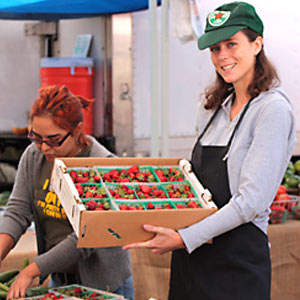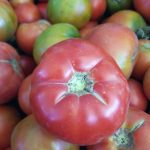Local: Define It, Demand It
Today, organic food and produce is widely available at the largest supermarket chains in Southern California and around the country. We tend to view this development as positive and with some perspective. Ten or fifteen years ago, we suspect that many would not have envisioned the largest mainstream supermarket chains becoming the largest retailers of organic foods. And in an effort to give credit where credit is due, we all owe a great deal of gratitude to Whole Foods Market. They were the pioneers.
From where the industry began to where we are now is night and day. Most sources agree that organic food sales have grown since the early 2000s—from 5 to 10 billion USD to today, where sales sit between 40 and 50 billion USD. See https://www.ota.com/news/press-releases/19681. As the desire for organic food and produce grows, simple economics would dictate that the market will adjust to meet that demand, and as production grows to meet demand, prices will come down on organic food and produce, thus making organic more accessible to all. All positive—consumers demanding healthier organic, lower prices and wider availability. The even better news? The market supply is still growing to meet the demand, and the demand is expected to continue growing for decades to come.
But now, consumers are demanding more than organic. Consumers also want to reconnect with their food sources and are demanding locally grown food. Perhaps we should pause here for a moment to clarify a point. A quick review of the literature on the subject indicates that there is some confusion about what local means. The confusion seems to be that the terms local and organic are synonymous. They are not. Local food can be organic or can be laden with pesticides, just as organic produce can be local or can arrive from another state or another country. If both organic and local are high on your priority list, care must be taken to ensure the veracity of both.
But what exactly does local mean?
In simple terms, buying locally is the concept of buying food that is produced, grown, or raised as close to where it is consumed as possible. In the end, the consumer must decide.
The real issue is that the term “close” varies depending on the source. Is it 50 miles? Is it 400 miles? Is it food that travels less than 2 hours? Is it food that doesn’t cross a state border? An international border? You see the problem.
There are definitions. A legal definition was established in the Food, Conservation, and Energy Act of 2008 (Public Law 110-234), which can be found here (https://www.gpo.gov/fdsys/pkg/PLAW-110publ234/html/PLAW-110publ234.htm), and states:
‘‘(I) the locality or region in which the final product is marketed, so that the total distance that the product is transported is less than 400 miles from the origin of the product; or
‘‘(II) the State in which the product is produced.
Just for ease of reference, 400 miles from Southern California could put the origin of your food in Utah, Nevada or Arizona and under the second prong of the definition, even farther. We suspect that when consumers are demanding local in Southern California, they are not thinking Arizona, Utah or Nevada. Other definitions are based on geography or perhaps a better term is ecosystem, wherein a local geographic area is defined by its watershed, climate, geology, food shed, animal species or even hydrologic region. By almost all of these definitions, the South Coast region of Southern California forms a distinct region (See for example: https://www.water.ca.gov/LegacyFiles/pubs/groundwater/bulletin_118/california’s_groundwater__bulletin_118_-_update_2003_/bulletin118_4-sc.pdf). A food shed is a relatively recent term and mirrors a watershed in its definition in that they both utilize the idea of water or food flowing from its origin to its final destination. Given this definition, a food shed could be extremely small or extremely large, as Michigan State University Extension points out:
With food products traveling an average of 1,300 miles in the United States, most of our current food sheds are considered global. However, there are many advantages to having more localized food sheds, defined as a food shed where food is consumed within 100 hundred miles of where it was produced. Think of a local farmers’ market or through a community supported agriculture (CSA) farm. Some of these benefits include fresher foods that keep our food dollars circulating in our local economy. Other benefits include a reduction in resources used in packaging and transport that would reduce emissions and combat climate change and solid waste disposal issues. http://msue.anr.msu.edu/news/what_is_a_food_shed
Bringing the discussion back closer to home, the Los Angeles Food Policy Council envisions two concentric circles around Los Angeles, one at 100 miles and another at 200 miles, they appear to set their limit of a food shed at 200 miles however. http://goodfoodla.org/good-food/what-is-a-foodshed/
The wave of people who are prioritizing local is growing so fast that they were given a name, locavore. The term locavore became so popular that it was named the Oxford Word of the Year in 2007! https://blog.oup.com/2007/11/prentice/
If you have read this far and followed any of the links, you are now aware that there are numerous ways to slice the term local, but that despite the lack of a definite milepost to define local, the basic concept remains: buying locally is the concept of buying food that is produced, grown, or raised as close to where it is consumed as possible. The term local represents a growing wave of consumers that wish to reconnect, to return to a relationship with their food, the animals, the plants, the land where these are grown and raised, the farmers, and importantly, with each other. But in the end, the consumer must decide where they draw the line and if Sage Mountain Farm fits your definition, we hope you will buy our produce.
At Sage Mountain Farm, we’ve made our own commitment to local, servicing only San Diego, Los Angeles, Orange, San Bernardino and Riverside counties—all within a 100 mile radius of our Southern California farm.
More About Buying Local

America’s industrialized food system threatens the health of our families, our communities, and the planet.
To fix this, NRDC is working to rebuild strong regional food systems. . .







